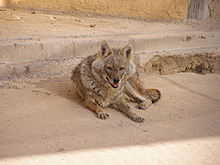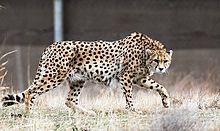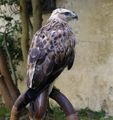|
Wildlife of IranThe wildlife of Iran include the fauna and flora of Iran. One of the most famous animals of Iran is the critically endangered Asiatic cheetah (Acinonyx jubatus venaticus), which today survives only in Iran.[1] HistoryThe animals of Iran were described by Hamdallah Mustawfi in the 14th century. In the 18th and 19th centuries, Samuel Gottlieb Gmelin and Édouard Ménétries explored the Caspian Sea area and the Talysh Mountains to document Caspian fauna. Several naturalists followed in the 19th century, including Filippo de Filippi, William Thomas Blanford, and Nikolai Zarudny who documented mammal, bird, reptile, amphibian and fish species.[2] FloraMore than one-tenth of the country is forested. The most extensive forest is found on the mountain slopes rising from the Caspian Sea, with stands of oak, ash, elm, cypress, and other valuable trees. On the plateau proper, areas of scrub oak appear on the best-watered mountain slopes, and villagers cultivate orchards and grow the plane tree, poplar, willow, walnut, beech, maple, and mulberry. Wild plants and shrubs spring from the barren land in the spring and afford pasturage, but the summer sun burns them away. According to FAO reports, the major types of forests that exist in Iran and their respective areas are:[3]
More than 8,200 plant species are grown in Iran. The land covered by Iran's natural flora is four times that of the Europe's.
Fauna Iran's living fauna includes 34 bat species, Indian grey mongoose, small Indian mongoose, golden jackal, Indian wolf, foxes, striped hyena, leopard, Eurasian lynx, brown bear and Asian black bear.[2] Ungulate species include wild boar, urial, Armenian mouflon, red deer, and goitered gazelle.[4] Domestic ungulates are represented by sheep, goat, cattle, horse, water buffalo, donkey and camel. Bird species like pheasant, partridge, stork, eagles and falcons are also native to Iran.[citation needed]
Endangered  As of 2001, 20 of Iran's mammal species and 14 bird species were endangered. Endangered species in Iran include the Baluchistan bear, Asiatic cheetah, Caspian seal, Persian fallow deer, Siberian crane, hawksbill turtle, green turtle, Oxus cobra, Latifi's viper, dugong, Panthera pardus tulliana, Caspian Sea wolf, and dolphin. At least 74 species of Iranian wildlife are listed on the IUCN Red List, a sign of serious threats to the country's biodiversity. Majlis have shown disregard for wildlife by passing laws and regulations such as the act that lets the Ministry of Industries and Mines exploit mines without the involvement of the Department of Environment, and by approving large national development projects without demanding comprehensive study of their impact on wildlife habitats.[5] The leopard's main range overlaps with that of bezoar ibex, which occurs throughout Alborz and Zagros mountain ranges, as well as smaller ranges within the Iranian Plateau. The leopard population is very sparse, due to loss of habitat, loss of natural prey, and population fragmentation. Apart from bezoar ibex, wild sheep, boar, deer, and domestic livestock constitute leopard prey in Iran.[6] Extinct
See also
References
External links
|












